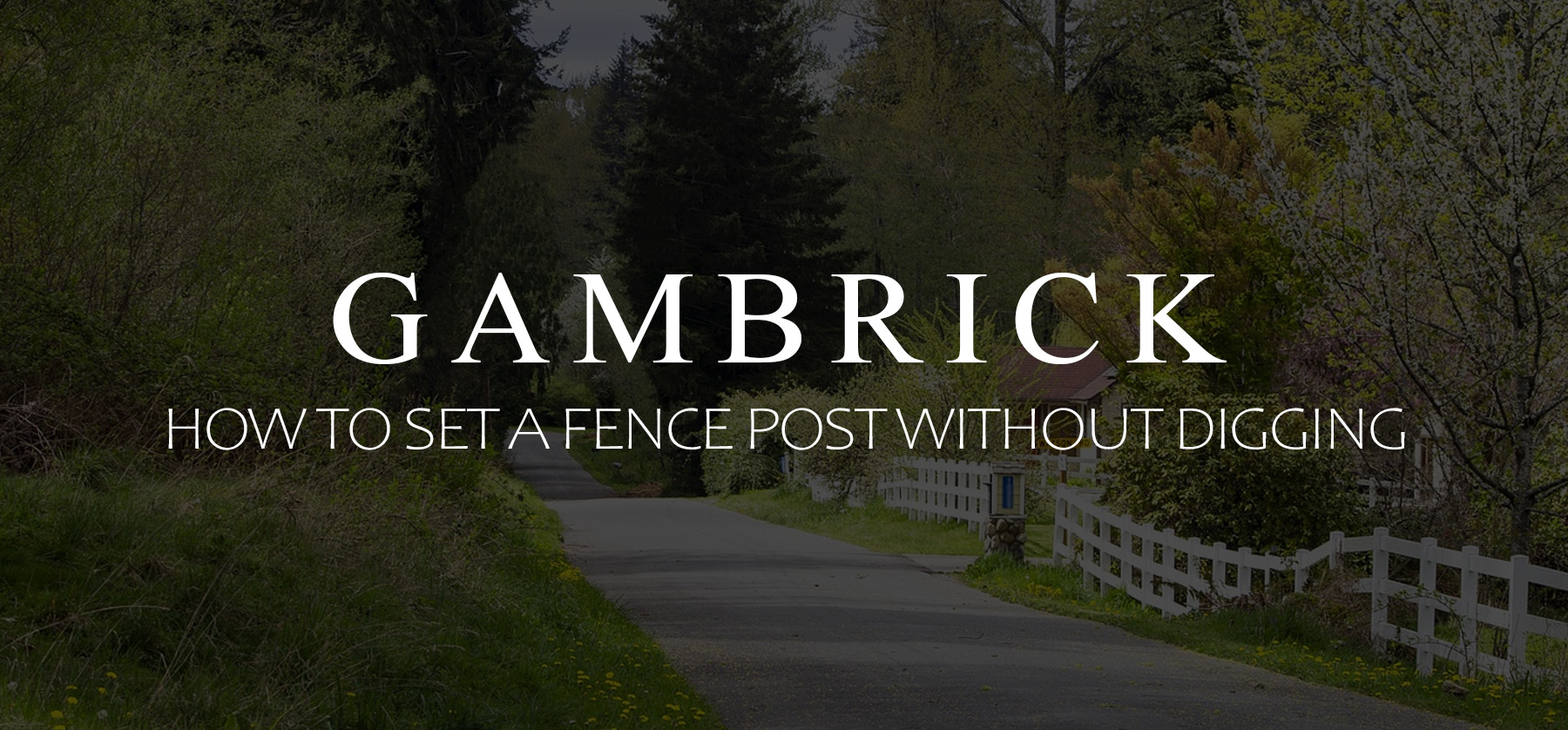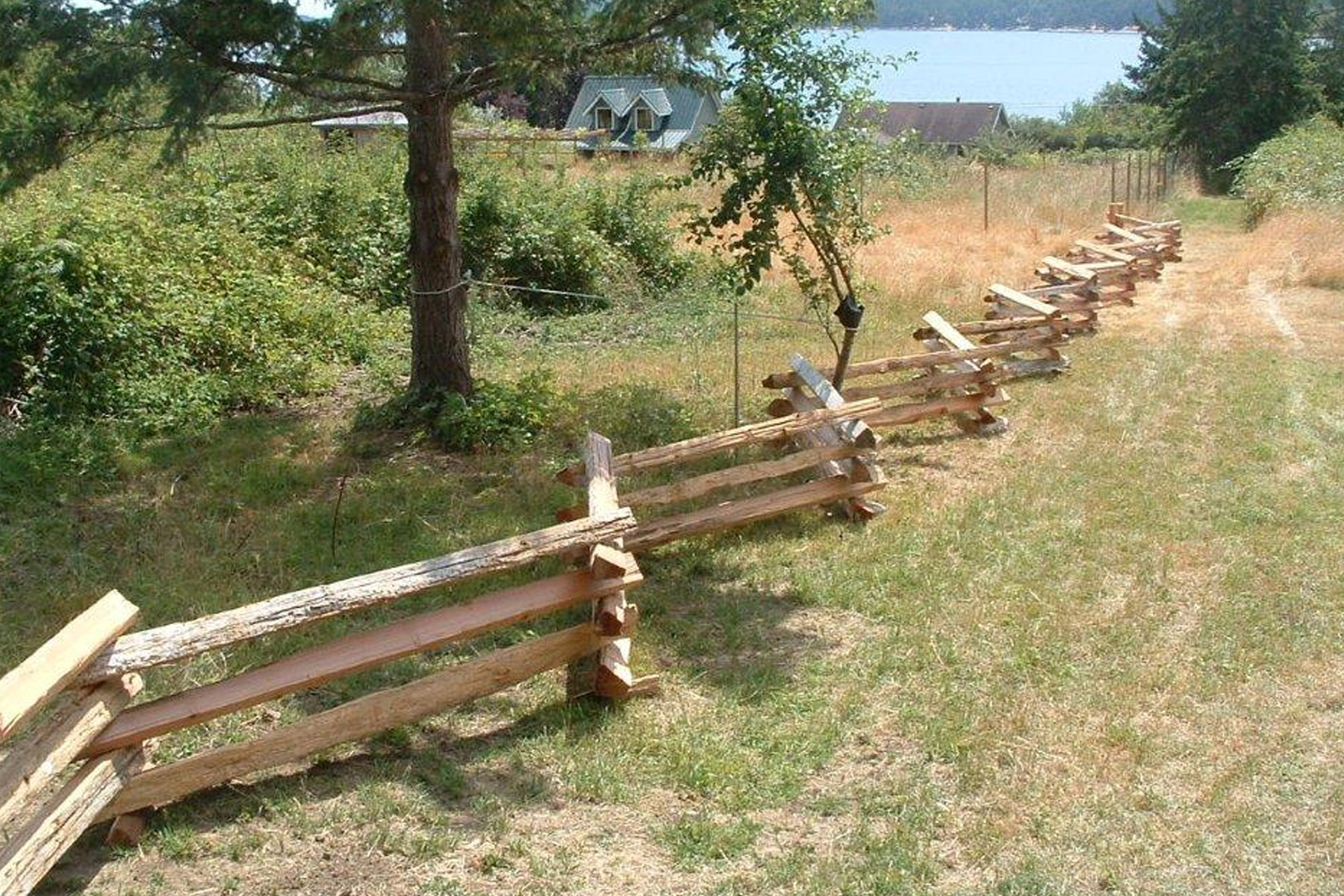How To Set A Fence Post Without Digging
The best way to set a fence post without digging is with a post anchor and sledge hammer. There are a few different anchor designs which we’ll discuss throughout the article, but the basic concept is the same. Pound the anchor deep into the ground and then bolt a fence post to the top of the anchor sticking out of the ground. The great thing about using post anchors is not having to dig or work with concrete. But it’s still hard work. Pounding a fence anchor deep into the ground isn’t easy, especially if you have hard or rocky soil.
Post anchors aren’t as strong as burying the post or setting it in concrete. But it’s still strong enough to support low fences. When you use an anchor, the post is attached to the anchor after it’s set in the ground. This connection is now the most common point of failure for your fence so use really strong bolts or the entire fence will be weak.
It’s hard to install a post anchor level and plumb because you can’t adjust it as you go. Make sure you drive the anchor carefully. Ultimately, the fence post will follow the same general direction as the anchor. If the anchor isn’t perfect, the fence post won’t be either.
Even though the idea is to set a fence post without digging, I still dig a small test hole first. A test hole tells me the soil conditions which helps choose the best anchor.
That’s basically it. Setting a fence post without digging is easy.
- Dig a test hole to check the soil conditions.
- Drive the anchor with a sledge hammer. Use a small piece of 4×4. Don’t hit the anchor with your sledge.
- Bolt the fence post to the anchor.
- Build your fence.
Metal Post Anchor
A metal post anchor is the best way to set a fence post without digging. All you need is the anchor, a sledge hammer, a 1 foot section of 4×4 and a small mini sledge to get started.
A post anchor is a very simple design. The top is a bracket that bolts into a fence post, this part of the anchor stays out of the ground. Make sure to bolt the fence post tightly to the anchor with strong bolts. This connection point is where most fences fail.
The bottom of the anchor is a big spike that gets hammered into the ground. This what gives the fence post strength.
Make sure to buy a post anchor that’s rated for the fence you’re installing. They’re generally not as strong as setting a fence post in a hole with concrete and don’t handle upward pressure well. So stay within the weight limits and restrictions set by the manufacturer or the fence could fail.
Most post anchors go into the ground about 30 inches. Keep this in mind when setting your fence post height. Most manufacturers recommend using post anchors for fences at or below 4 feet.
The above ground part of the post anchor is about 4 inches. This is the area you slide the 4×4 into.
Most post anchors are made of steel and weight around 4-5 pounds. Stay away from cheap anchors you can find online. Check the weight before you buy. A good quality anchor is made from thick metal and should weight between 4-5 pounds each.
Installing A Post Anchor
Installing a post anchor is really easy. Basically all you do is hammer it into the ground while keeping it level and plumb. You’ll need a sledge hammer and a 1 foot cut off section of 4×4 post.
- Instead of digging a hole for your fence post, use a metal spike anchor to secure the post.
- Insert the 1 foot section of 4×4 into the anchor. This is what you hit with the hammer. Don’t hit the metal anchor with your sledge hammer. Once the anchor is in place you can remove this section of post.
- Pound the metal spike into the earth with a sledgehammer until just the top is sticking out of the ground. Start pounding with a mini sledge until it can support itself, then start hitting with a heavy sledge. Make sure the spike stays level and plumb as you drive it into the ground.
- Take your fence post and place it into the top of the spike that’s sticking out of the ground.
- Once the post is in place, secure it with bolts. Make sure you use strong bolts because this is the most common place the fence will fail.
After you’ve set the first post, repeat the process until you’ve installed all your posts. I like to install my corner and end posts first. Then I string a line between the corner and end posts as a guide. This keeps all the inner posts in line and helps with the lay out.
Installing fence posts without digging is still hard work. The spikes don’t always go in easy. But overall, I think it’s easier than digging post holes. Especially if you’re also using concrete.
Simpson E-Z Spike
The E-Z Spike is a type of post anchor made by Simpson and is part of their Strong-Tie line of products. It allows for easy installation of 4×4 wood fence posts without digging holes or pouring concrete.
The E-Z Spike is basically the exact same product as the post anchor we already discussed only it’s very good quality. Simpson makes the post out of 18 gauge steel so it really holds up well over time. It also has more holes for securing the post to the anchor. This is the most common area these post anchors fail so adding more connection points is a big plus. Also Simpson makes the bolts that secure the spike to the post which makes things easier. But quality comes at a price, the Simpson E-Z Spike and their bolts are over twice the cost of cheaper post anchors you can buy on Amazon.
- Made from 18 gauge steel.
- Can be used to install fence posts without digging.
- Includes black powder-coated steel which has more reliable strength and a nicer finish.
For installation instructions and tips review the previous section on post anchors because their exactly the same.
Warning About Using Post Spike Anchors
Fence post anchors like Simpson’s E-Z Spike should not be used for solid fences in excess of 4′ in height or that are unprotected from wind forces.These types of products work great for installing a fence post without digging, but they’re not rated for uplift loads. This is very common in a wind storm.
Post anchors are not recommended with posts for overhead structures or any other structure that requires resistance to wind uplift loads.
The bottom of the anchor is basically just a pointed spike that gets hammered into the ground. But there’s nothing to prevent the spike from getting pulled out. They work sort of like a nail. I’ve pulled post anchors out of the ground with my bare hands. A strong upward wind could pull them right out of the ground.
The typical fence post is buried a third of it’s total length in the ground. For example, a 6 foot high fence post would be buried 2 foot in the ground. Keep this in mind when using post anchors too. They work best with fences around 4 foot high or less because they’re only about 30 inches in the ground.
Anchor Base
Another way to set a fence post without digging is with an anchor base. These are basically the top section of a post anchor except without the spike. Instead of a spike, you bolt the anchor base onto an existing concrete slab.
Keep in mind, this is only for setting fence post on an existing concrete slab. They don’t work on dirt. However, they would work fine on solid rock.
Basically the post anchor base is square with 4 holes, one on each corner. Place the base down onto the concrete and mark the holes. This is where the bolts will go. Use a masonry bit and hammer drill to drill holes into the concrete. Then bolt the post base anchor in place.
Make sure to use exterior concrete anchor bolts to secure the post base. This is a very string way to secure a fence post because in order to rip out the base you’d have to also tear out the bolts or concrete.
As with anchor spikes, the weak point is where the wood connects to the metal bracket. This is the most common point of failure I see. Use strong bolts to connect the wood post to the metal anchor.
Buck Fence
A Buck Fence, a.k.a. a Jack Fence or Jackleg Fence, is a traditional rustic style fence that doesn’t have posts set in the ground.
The buck fence is a versatile design because you can build it on all sorts of terrain where you can’t dig post holes. This even includes solid rock.
Jack fencing doesn’t require any post holes which makes it fast and easy to build. All you need is the the lumber and fasteners to hold it all together.
You build a jack fence by placing two posts in a “x” shape so that they lean on one other. Then horizontal beams are installed from x to x. They stay up sort of like big saw horses. Once the horizontal beams are set in place the fence stays up by itself without any post holes or anchors. They sit on the ground rather than being installed into it.
Buck fences are not intended for privacy, rather, they’re for keeping animals in or out. But there’s no reason you couldn’t install some solid paneling if you wanted it.
I recommend adding a diagonal every 4-6 sections from the top of one buck to the bottom of another to prevent racking. I also recommend a short 4’ rail at the bottom of the buck to keep the legs from spreading apart.
Use fasteners that are rated for outdoor use otherwise they’ll rust. A long time ago people used rope to build jack fences, which will still work today if you want a truly authentic look.
Buck fences are seen as a working type of fence and less as a cosmetic option. Typically we build them on farms with lots of land and not a suburban setting.
Snake-Rail Fence
Snake Rail Fences are another rustic style fence that doesn’t use fence posts which means no digging or concrete work. Each sections zigzags and the rail ends overlap which keeps them upright and strong. Snake fencing, a.k.a. zig-zag fence, are among the most recognizable split rail fences.
Board lengths are typically around 11 feet long which provides a 7 foot section. Fences are typically built 3-4 rails high which is under 4 foot.
Each snake rail is triangular in shape and around 6″per side. They’re stacked in either an alternating one up one down pattern or an overlapping shingled pattern. Singled tends to work best if you’re going up a slope or over uneven ground.
Rail sections can be fastened together with screws, bolts, nails or rope.
You can build a snake rail fence right on the ground but I recommend placing the bottom rail on a masonry block or small section of rail to prevent rotting. This can also help keep the fence level.
Like the jack fence, snake-rail fences have many names, such as:
- Split-rail fence
- Log fence
- Round-pole fence
Snake rail fences were traditionally used to keep in animals, but these days many are built just for looks. They’re an attractive rustic fence design that can also serve a functional purpose.
Metal Posts
Almost all chain link fences are installed using metal steel posts. The benefit of using these posts is that they’re strong and hollow, which means you can set them in the ground without digging a hole first. What you need for this is a T-Post Driver, a.k.a. a fence post driver.
Metal posts are driven right into the ground just like a spike anchor, but you don’t typically do it with a sledge hammer. You use a T-Post driver. Basically you lift the driver up and smash it down onto the top of the post. It’s specially designed to work with metal posts which makes install easy. Just keep lifting and smashing the post down until it’s at the required depth.
As with anchors, make sure you keep the post level and plumb as you drive it into the ground because you can’t adjust things as you go.
Steel posts can push through rocks and hard soil which provides a strong base for your fence.
If you don’t have a t-post driver a sledgehammer will work too. Just make sure not to hit the metal post itself or you’ll damage it. Get a section of 4×4 and put it on top of the post. Hit the wood instead of the metal.
Summary: How To Set A Fence Post Without Digging
The best way to set a fence post without digging is with a post anchor and sledge hammer. There are a few different anchor designs which we’ll discuss throughout the article, but the basic concept is the same. Pound the anchor deep into the ground and then bolt a fence post to the top of the anchor sticking out of the ground. The great thing about using post anchors is not having to dig or work with concrete. But it’s still hard work. Pounding a fence anchor deep into the ground isn’t easy, especially if you have hard or rocky soil.
Post anchors aren’t as strong as burying the post or setting it in concrete. But it’s still strong enough to support low fences. When you use an anchor, the post is attached to the anchor after it’s set in the ground. This connection is now the most common point of failure for your fence so use really strong bolts or the entire fence will be weak.
It’s hard to install a post anchor level and plumb because you can’t adjust it as you go. Make sure you drive the anchor carefully. Ultimately, the fence post will follow the same general direction as the anchor. If the anchor isn’t perfect, the fence post won’t be either.
That’s basically it. Setting a fence post without digging is easy.
- Dig a test hole to check the soil conditions.
- Drive the anchor with a sledge hammer.
- Bolt the fence post to the anchor.
- Build your fence.
If you have any questions or comments about setting a fence post without digging, Email any time.























